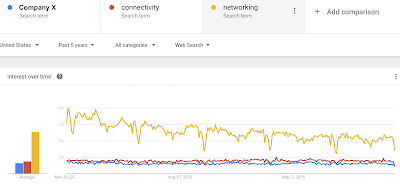The press release is thought to have been
first introduced 110 years ago by Ivy Lee, considered the father of modern
public relations. Lee’s agency was working with the Pennsylvania Railroad to manage
communications around the 1906 Atlantic City train wreck.
The release was provided directly to journalists, before other versions of the
story could be spread and reported.
Fast forward, much about communication
and disclosure has changed radically. Press releases are distributed via paid
wire services instantly and simultaneously to the media AND everyone else, with an immediate social media feedback
loop attached. The speed, breadth of reach and mode of access to press releases
could not be more different, yet how
have investor communications evolved to adjust to today’s completely different
paradigm?
To assess the status and relevance of today’s IR news
release practices, we focused on quarterly results press releases – the
workhorse of IR messaging. Though
voluntary, quarterly releases are used widely to communicate to investors about
a firm’s financial performance. A 2006 study by Dr. Elaine Henry confirmed that
investors are influenced by how earnings press releases are written, and Warren
Buffet has stated he would not invest in a company whose disclosure he cannot
understand, because this implies intentional obfuscation. [1]
Our research involved reviewing 84
quarterly releases issued on three randomly selected days in July and August
2016.
…what we seem to be observing is the
difference between “disclosure” and
“communication” in quarterly releases…
Release headlines were analyzed based on the following
criteria:
|
Quarterly Release Headline Analysis
|
Yes
|
No
|
|
Is there a financial measure in
the headline?
(i.e.
“EPS of $1.25”, “Net Income of $23.2M” or “Revenue of $3.8B”)
|
9%
|
91%
|
|
Is there any indication of 1/4ly
performance direction?
(terms like “record,” “rises,”
“declines” or “improves”)
|
18%
|
82%
|
|
Is there an explanation of
“drivers” behind the results?
(such
as “due to sales of the new software release” or “improved cost management
and acquisition synergies”
|
0%
|
100%
|
|
Is it clear what the company
does? / their general industry category? (United Rentals & Puget Sound Bancorp are clear, but it’s hard to
guess what PTC, or Umpqua actually do…)
|
58%
|
42%
|
|
Quarterly Release Headline
Content
|
|
|
|
Action word:
|
Reports
69%
|
Announces
25%
|
Other
6%
|
|
Period Description:
|
Second Quarter
91%
|
Other
7%
|
None
2%
|
|
Is the Year Included?
|
Yes
83%
|
No
17%
|
n/a
|
|
What quarterly measure is reported?
*(Results 49%; Financial Results 30%;
Financial and Operating Results 5%; Other results 4%)
|
Results*
88%
|
EPS
6%
|
Other
6%
|
And we also considered a few areas of release content:
|
Quarterly “Earnings” Release
Content
|
Yes
|
No
|
|
Are additional tables used to
help illustrate the results?
|
44%
|
56%
|
|
Does the release provide
perspective on future results / trends?
|
70%
|
30%
|
|
Does the release explain key drivers
behind the results?
|
94%
|
6%
|
|
Are comprehensive financial
statements provided in the release?
|
87%
|
13%
|
|
Was the complimentary logo
provided in wire service version?
|
71%
|
29%
|
As you can see, our primary focus was headlines – the point of discovery for any quarterly release, and we saw that:
(a) most quarterly results releases were virtually identical and undifferentiated, and
(b) most companies avoided discussion of their numerical results, underlying trends or drivers in their headline.
Most also opted not to explain the nature of what their company does beyond the name, which in 42% of instances provided no help. In general, the headlines we reviewed provided little perspective that might help their story become discovered by new investors.
This evidence suggests that – knowingly or not – the releases
are being written with existing investors as the principal audience. We come to this
viewpoint because few companies took steps to catalyze new investor attention by providing more qualitative
or quantitative information in their headlines to better illustrate the
investment to those who don’t know the story.
In our thinking, such information
might assist a prospective new investor in determining that they should “click on the link” or “open the email” rather than ignoring the item and moving on – a lost opportunity
for new engagement.
Please note that our perspective focuses more on small and microcap
companies that face challenging barriers for coverage or visibility of any kind
– making the optimization of their news release content even more critical to developing
new interest in (and demand for) their shares.
How IR
Press Releases Are Delivered and Consumed Today
But returning to Ivy Lee, much
has changed from a time when the media was THE gatekeeper and the principle conduit of news and information. Today, financial
news releases are disseminated instantly, globally and are consumed directly by investors in an electronic format either online or via email. Can you recall the last time you read breaking news
on paper?
Disclosure History Digression
Going back to the late 1980s / early 1990s, quarterly press releases reviewed operating results that were disclosed in paper-based 10-Q or 10-K SEC filings. Releases were sent in paper form directly to the media and paid wire services by messenger, mail or even relayed via phone calls but only those who visited an SEC reading room (principally in Washington, DC) – or contracted a service to do so – could access SEC filings.
Paid wire services would receive hard copy press releases, re-key them into their system and then distribute the release content electronically to their network of media subscribers. Given constrained access to SEC filings, the quarterly press release was the most broadly distributed disclosure. Yet the media’s succinct coverage of quarterly results (via major news wires like Dow Jones, Reuters, AP & Bloomberg – and the publishing of “earnings tables” in the Wall Street Journal, etc.) was the most immediate, visible and impactful source for most investors and the principal driver of the markets.
Facsimile transmission arrived in the 1980s to “revolutionize” release dissemination to media and investors, but only in the mid 1990s did the SEC mandate electronic filings on Edgar. At the same time the dawn of the Internet and proliferation of email was making Edgar and press release access broadly and immediately available.
Today, via paid wire services, quarterly news is instantly pushed to all major financial portals and SEC filings are immediately accessible via Edgar, a substantial change to the dynamics of news distribution and access – yet it seems little has changed in quarterly news content, despite the radical change in its use and the way it is accessed.
In this new world of electronic
delivery, quarterly news release visibility is distilled down to a headline
hyperlink on a web page or an email subject line, and both require a definitive
action by the viewer to see more – including any sub-headlines, highlights, tables
or the full release.
All the fine writing, financials,
background, historical perspective, informative links or insightful management
commentary are for naught – if the prospective investor is not persuaded to
click your headline link or open your release email. For that reason, we counsel
our clients to differentiate their headlines to make them more effective in
communicating specific information about your company.
“The most precious resource on
Wall Street is time – not capital…”
Yet our survey finds most
headlines lack such enhancements to better stimulate engagement and further review.
Said another way, most releases inherently assume they will be read and/or they
seem to assume some level of subsequent dialogue or research on the part of the
investor.
So let’s turn to some recommendations on
how to optimize the reach of quarterly releases– while not negatively impacting
the dialogue with those already converted.
1. Remove obvious, empty-calorie words from your headline and
replace with value-added content such as the date and or time of the webcast!
Investors are busy – get to the point, make things easy for them – plus fewer
words are cheaper!
ABC Group, Incorporated to
Report Fiscal 2016 Third Quarter
Financial Results of Operations and Host an Investor
Conference Call and Internet Webcast
ABC Group Reports Q3 Results and
Hosts
Call Wednesday, November 2nd at 4:30pm ET
2. If
your company name does not clearly explain your business, add a phrase in your headline to clarify your sector/industry to
increase the odds your news will be discovered by editors, investors,
reporters, blogs, other industry participants and search engines interested in
your sector.
“Company X Reports Fiscal 2016 Second….
“Connectivity and Networking
Solutions Provider Company X …”
To illustrate this thinking, BusinessWire’s social guru Serena Ehrlich suggests using Google Trends to research the prevalence of search activity around possible headline key words. This example uses a company that produces connectivity and networking products, but their corporate name was a family name that provides no clue as to the nature of their business or products.
The blue line shows search activity for the Company name, and the red and yellow lines represent search activity for the words “connectivity” and “networking.” Clearly, by simply adding the word “networking” to their press release headline, Company X would benefit from much higher visibility and potential discovery via searches or data mining / data analytics.
3. Use a financial measure(s) (Revenue,
net income, EPS, etc.) in your headline to provide a clear window on the scale of your business and
valuation, relative to readily available share price/market cap data, to help
readers assess your story’s relevance to their strategy.
Rather than:
“Company Y Announces Fiscal 2016 Second
Quarter …Results”
“Company Y Reports Q2 Revenues of $125M”
A frequent pushback on this concept is the concern of precedent and that such a measure must be reported when it is unfavorable. While we cannot reject this concept, the fear of having to highlight an uncertain future event does not seem sufficiently objectionable to adhere to flavorless headline structures that provide no exposure augmentation potential.
Our thinking was also echoed in a graduate paper: “Headlines are a framing feature that can be used to capture and retain attention with the ultimate intention of affecting the thoughts and feelings of readers, thus influencing their opinions. Therefore, headlines have a key role in a company’s communication strategy.”
4. Add an element of performance direction
to your headline to attract new investors with appropriate investment styles (growth, special
situations, turnarounds, value, etc.) Getting the direction of your performance
out more broadly – whether up or down – should reach more new relevant investors.
“[Digital Content Provider] Company Y Q2
Revenues Rose 22% to $125M”
5.
A
step further would be to explain a key
driver behind the change of the measure.
We suggest:
“[Digital Content Provider] Company Y Q2
Revenues Rose 22% to
$125M, Driven Principally
by New Distribution Relationships”
or
“[Specialty Chemicals Distributer] Z Corp. Q2 Revenues declined 17% to
$325M, Reflecting Impact of Price Competition and Scheduled Plant Maintenance”
6. Similarly,
we recommend that you include key
elements of your conference call comments in the press release, – not just on
the call which has a fraction of a release’s reach and engagement, particularly
with retail investors. This includes business drivers, industry trends and
management strategy that will impact your future results.
7. Include
comprehensive financial statements in your wire service release, as 13% of
releases we surveyed did not take this simple step to push their financials to
investment portals on a global basis. This is where investors may first
discover you.
Further, if your performance is strong and the numbers show
it clearly, a comparison table with
percentages is a great addition to a successful release. 56% of releases surveyed
did NOT take advantage of this opportunity. In our view tables with a % or $ change column make operating improvements far more apparent than do words.
8. Finally, take advantage of all that the online world has to offer to enhance your news – assuming you are successful in getting an investor to look at your release. Graphics, images, video and hyperlinks to sources that build upon the release content and context will enhance the success of your message. Also, social media provides a “force multiplier” benefit to your disclosures by providing the opportunity to position your news in front of new viewers through the smart use of key words, hashtags and appropriately noted stock symbols (“cashtags”).
We advocate adding more
content to your headline to make it more effective in communicating – rather
than merely disclosing your performance. Interestingly, 83% of the survey releases chose to clarify the year of the results they were reporting in the headline (when that is both understood AND clarified in the release itself), yet 91% of the releases chose to NOT reference any measure of
financial performance in the headline (despite that being the reason for the release), and 82% also
refrained from providing any directional context on their quarterly
performance.
The decisions driving headlines that provide so little relevant information seem based in an orientation toward “disclosure” rather than “communication” in quarterly
releases. The bulk of releases surveyed
erred on the side of unembellished disclosure, to the detriment of their potential reach and utility. This approach also begs the question of why even bother issuing a release if it provides no more perspective or utility than the
10-Q or 10-K?
The most precious resource
on Wall Street is time – not capital, making it incumbent upon the IR practitioner
to make it efficient and easy for investors to get to the data they need. The
fewer the steps, the more likely they will make the journey.
We also surveyed the use of a
complimentary corporate logo in wire service releases. We were surprised to
find that just over 2/3rds took advantage of this free, easy to use
feature that provides a more compelling visual portrayal of your news that also reinforces your corporate branding. That nearly 1/3rd of releases did not use this free feature does make us wonder about their thought process in passing up the opportunity.
Summary: While we are all too aware of myriad forces at work in shaping corporate disclosure, we believe it is the role of the IRO or IR consultant to advocate
for the “communications” opportunities within quarterly and other news and at least
ensure that key decision makers are aware of the pros and cons of the current
approach versus alternatives that might enhance communications reach.
Impediments to change in quarterly communications can be huge – as we have often observed
over decades of IR consulting. The status quo carries probably the greatest
weight in the homogenization of quarterly release content – with “we’ve done it
this way for years” or “it’s the way our leading peers communicate”
as two prominent justifications. We also know well the extra time and attention that required to successfully champion such changes – both to develop and then advocate for and defend. Even a receptive audience will often want to table changes until “next
quarter,” when the sponsorship burden reemerges.
While our study just scratched the surface,
we believe the questions the data raises are germane to the ROI of today’s IR
communications. These questions include:
· Who is your audience? What are your communications goals?
· What are you trying to achieve with your news release? With
your headline?
· Have you maximized your potential communications value?
· How should the evolution of communications technology and distribution inform our content and processes?
Many thanks to Anna Vikentiev, our
intern and Fordham Gabelli School of Business Master’s Degree candidate in
Investor Relations, who conducted the research and contributed to the writing
of this article. Without Anna – this would still be an idea.
We welcome feedback or questions on our
research findings and recommendations.



